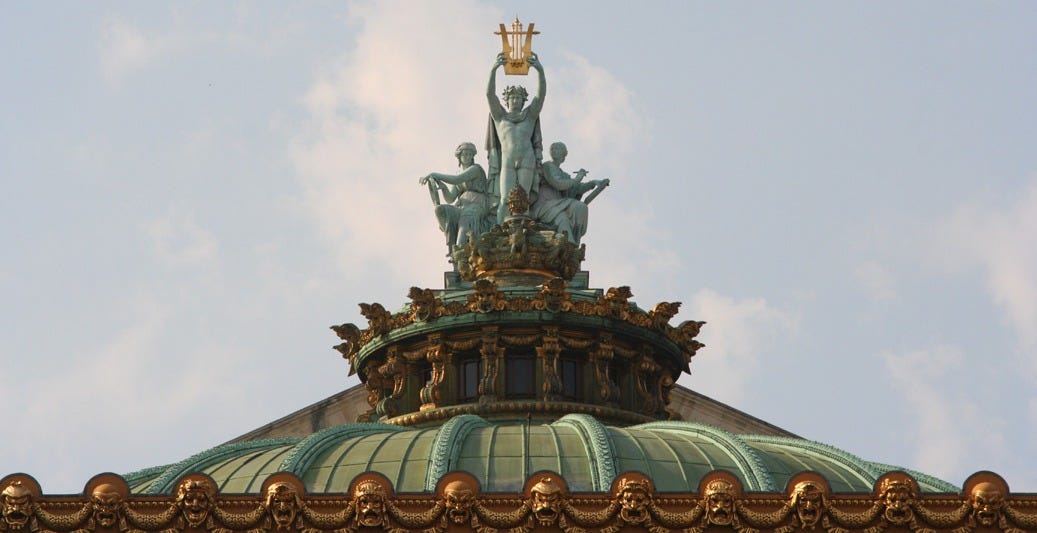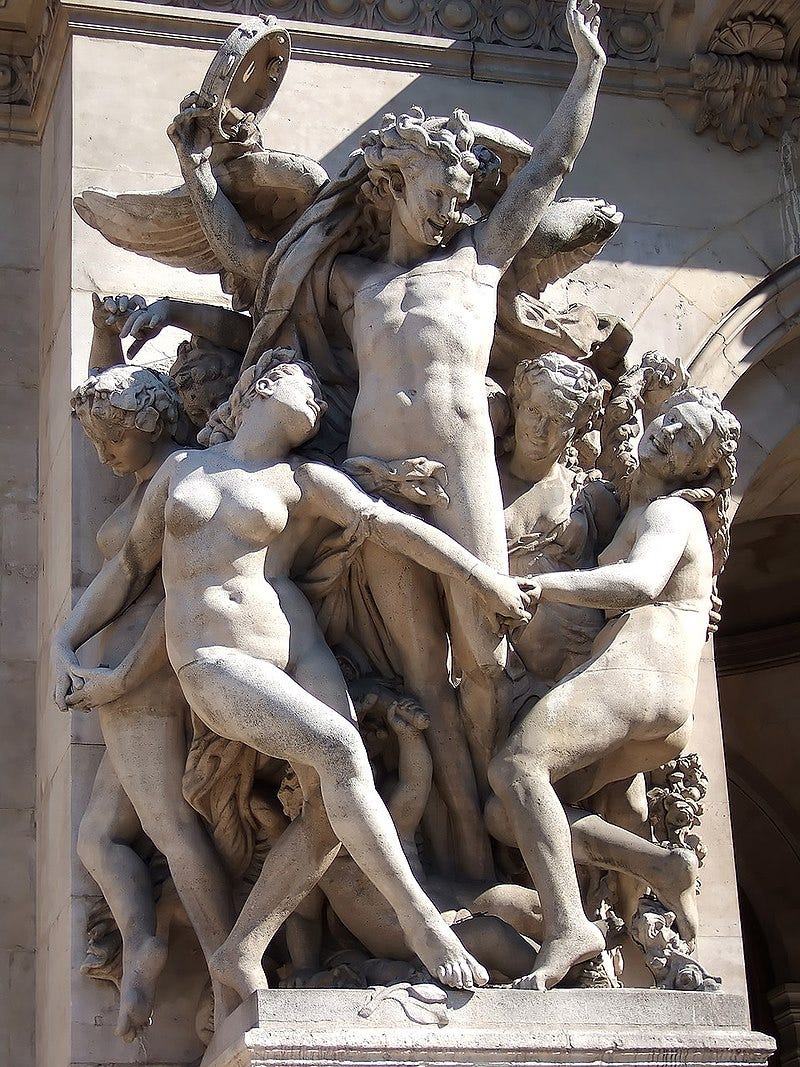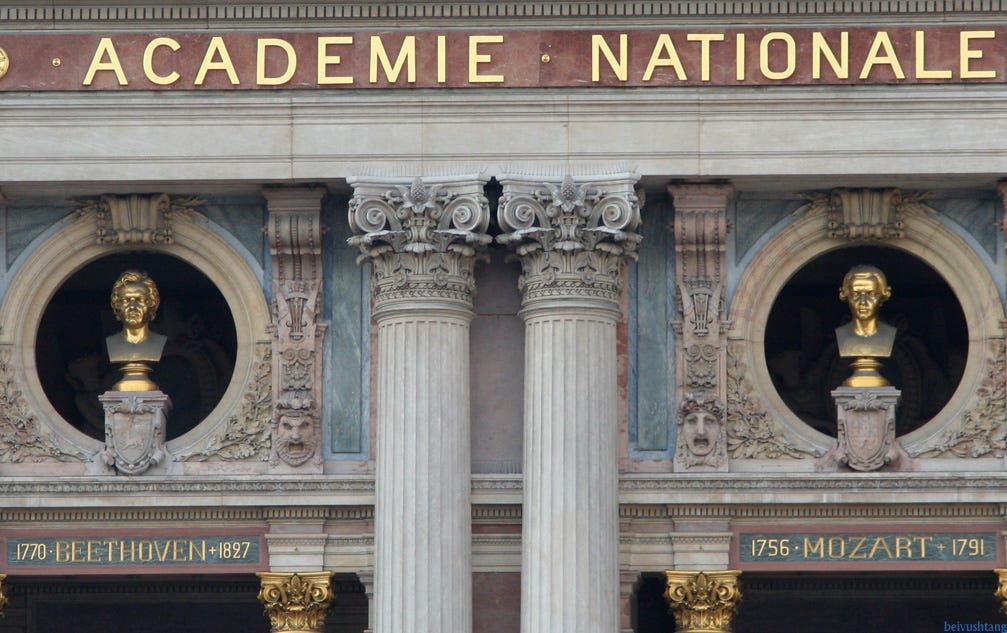Bonjour, Dear Reader
Today, we’re stepping into the opulence of the Palais Garnier, the legendary Parisian opera house that’s as much a monument to beauty as it is a stage for grand performances. You’ve likely seen it in photos or heard its name whispered in tales of The Phantom of the Opera, but there’s so much more to this architectural marvel.
So, let’s wander through its glittering halls, and marvel at the artistry that makes it one of the world’s most iconic landmarks.
Grab a café au lait, and let’s begin our journey into this Parisian masterpiece.
A Grand Vision
The Palais Garnier was born from the audacious dreams of Emperor Napoleon III. In the mid-19th century, Paris was undergoing a radical transformation under Baron Haussmann’s urban overhaul, with wide boulevards and grand buildings redefining the city. Napoleon wanted an opera house to match this new vision of imperial splendor.
Charles Garnier was a young and relatively unknown architect who, at 35, won the commission in 1861 with a design so bold it reportedly made Napoleon’s wife, Empress Eugénie, scoff
“What is this? It’s not a style; it’s neither Greek nor Roman!”
Garnier’s response?
“It’s Napoleon III style, Madame!”
And so, the Palais Garnier became the crowning jewel of the Second Empire’s aesthetic—a flamboyant blend of Baroque, Renaissance, and pure theatricality.
Construction began in 1862 but was no easy feat.
The site was swampy, requiring eight months just to pump out groundwater. Then there was the small matter of a subterranean lake, literally, which inspired Gaston Leroux’s Phantom of the Opera. The project took 14 years, interrupted by the Franco-Prussian War and the fall of Napoleon III’s regime. When it finally opened in 1875, the Palais Garnier was a symbol of resilience as much as opulence, costing a staggering 36 million gold francs (roughly €200 million today).
But oh, was it worth it!
The Exterior: A Symphony in Stone
Its façade is a love letter to excess, crowned by a green patinated dome and the glittering statue of Apollo, lyre in hand, soaring 7 meters tall atop the roof. Flanking him are allegorical figures of Poetry and Music.

The façade is adorned with 14 sculptors’ works, including Jean-Baptiste Carpeaux’s dynamic La Danse, a swirling group of bacchantes that scandalized Parisians for its sensual exuberance—so much so that someone threw ink at it in protest!

Look closely, and you’ll spot busts of composers like Beethoven and Mozart, nestled among garlands, columns, and friezes that seem to dance across the stone.

The loggia, with its double staircase leading to the entrance, is a nod to Renaissance palaces, but the sheer scale—spanning 125 meters in length—makes it feel like a temple to art itself. It’s no wonder Victor Hugo called it
“a palace for fairies.”

The Interior: A Labyrinth of Splendor
Inside, the Palais Garnier becomes a fever dream of luxury. The Grand Staircase, a soaring marble masterpiece, is where you first lose your breath. Its curve balustrades lead you up under a ceiling dripping with frescoes and chandeliers.

Then there’s the Grand Foyer, a 54-meter-long hall that outshines even Versailles’ Hall of Mirrors. Its barrel-vaulted ceiling, painted by Paul Baudry, bursts with allegories of music and dance, while gold leaf covers every surface like liquid sunlight. Mirrors reflect endless chandeliers, creating a kaleidoscope of light that makes you feel like you’re waltzing through a jewelry box.

The auditorium itself is a crimson and gold cocoon, seating nearly 2,000 under a breathtaking ceiling painted by Marc Chagall in 1964. Chagall’s vibrant, dreamlike mural—a swirling tribute to composers like Wagner and Ravel—replaced the original, more staid painting, sparking controversy for its modern flair.

Look up, and you’ll also spot the 7-ton chandelier, a glittering behemoth that famously plays a role in Phantom of the Opera (and yes, it did once fall in 1896, killing a spectator).

Secrets and Hidden Wonders
The Palais Garnier is full of surprises.
That subterranean lake? It’s real, lurking beneath the foundations and still maintained to stabilize the building. Firefighters even train in it!
Then there’s Box 5, reserved for the Phantom in Leroux’s novel, which you can still see today, complete with a plaque for the fictional ghost. The opera house is riddled with hidden passages and trapdoors, designed for stage machinery but perfect for fueling tales of mystery.
Palais Garnier was once also a hub for espionage. During World War II, its labyrinthine corridors hid Resistance fighters, and its cellars stored props and secrets alike.
Garnier himself was nearly bankrupted by the project, pouring his soul (and wallet) into every detail, from the 30 types of marble to the custom-designed doorknobs. His obsession paid off, but he barely got to enjoy the opening—Napoleon III’s fall meant Garnier wasn’t even invited to the inauguration. Imagine that!
Artistic Alchemy: Sculptures and Symbolism
Beyond Carpeaux’s scandalous La Danse, sculptures abound, from the gilded Harmony and Fame figures on the roof to the intricate bas-reliefs depicting muses and myths. Inside, every corner is a canvas: frescoes by Isidore Pils in the Grand Staircase, mosaics in the foyer, and allegorical statues of Drama, Lyric Poetry, and more.
The building itself is a total work of art. Garnier even designed the furniture, ensuring every chair matched the building’s opulent DNA.
Today, the Palais Garnier remains a working opera house, hosting the Paris Opera Ballet and occasional performances, though the Opéra Bastille now handles most operas. Yet its allure endures.
So, Dear Reader, when you’re in Paris, step into this gilded dreamscape, and let its splendor wash over you.

Until our next cultural adventure, keep your eyes open and your heart curious.
Muse
Missed our last story? Read it here↓
Don’t miss the newest episode of our podcast!
Thank you for being part of Cultural Canvas! If you love what we do, consider supporting us to keep it free for everyone. Stay inspired and see you in the next post!




Merci beaucoup Muse! I missed it this last trip😔 awww what a marvel really really a marvel thanks for posting!